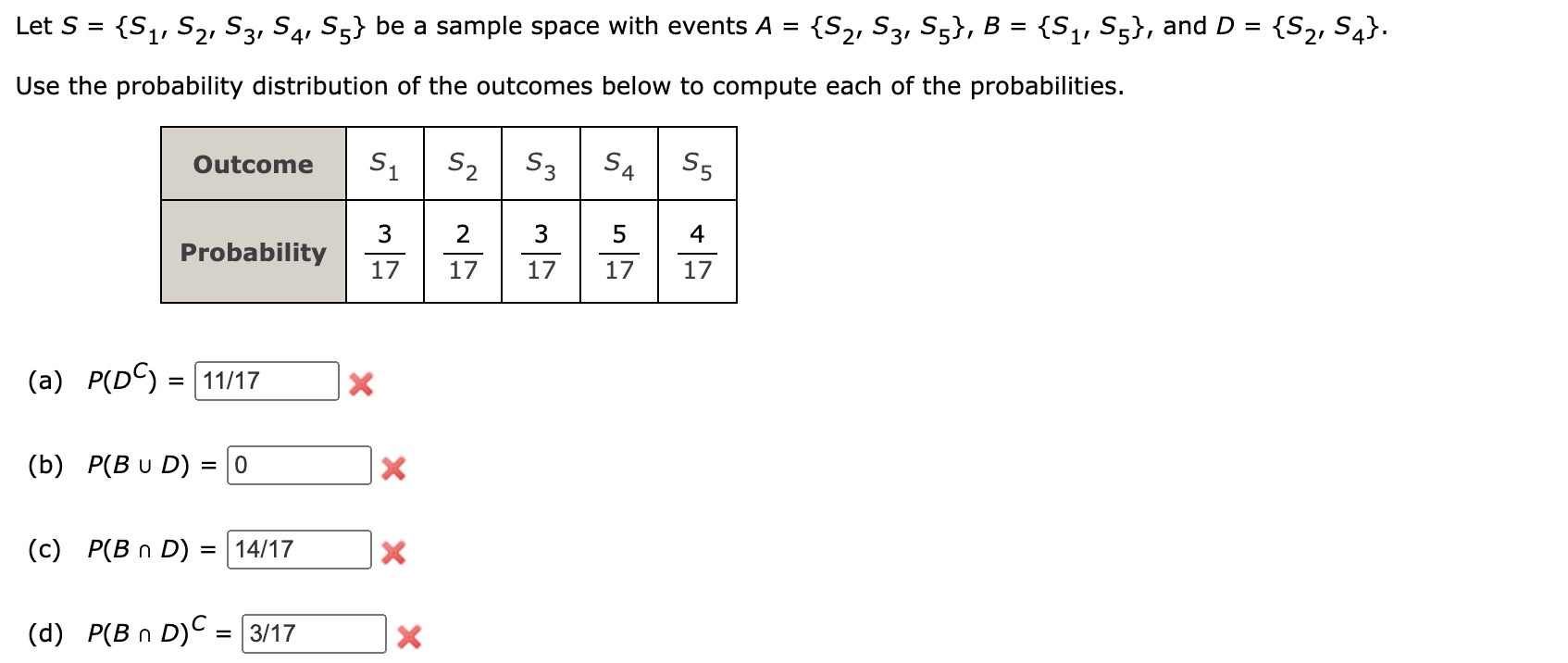Let S = {S1, S2, S3, S4, S5} be a sample space with events A = {S2, S3, S5}, B = {S1, S5}, and D = {S2, S4}. Use the probability distribution of the outcomes below to compute each... Let S = {S1, S2, S3, S4, S5} be a sample space with events A = {S2, S3, S5}, B = {S1, S5}, and D = {S2, S4}. Use the probability distribution of the outcomes below to compute each of the probabilities: (a) P(Dᶜ) = ? (b) P(B∪D) = ? (c) P(B∩D) = ? (d) P((B∩D)ᶜ) = ?

Understand the Problem
The question provides a sample space S and three events A, B, and D defined as subsets of S. It also gives the probability distribution for each outcome in S. The task is to compute the probabilities of the complements, unions, and intersections of these events: P(Dᶜ), P(B∪D), P(B∩D), and P((B∩D)ᶜ). The provided answers are incorrect and the user needs assistance in calculation the correct probabilities .
Answer
(a) $P(D^c) = \frac{10}{17}$ (b) $P(B \cup D) = \frac{14}{17}$ (c) $P(B \cap D) = 0$ (d) $P((B \cap D)^c) = 1$
Answer for screen readers
(a) $P(D^c) = \frac{10}{17}$ (b) $P(B \cup D) = \frac{14}{17}$ (c) $P(B \cap D) = 0$ (d) $P((B \cap D)^c) = 1$
Steps to Solve
- Calculate $P(D^c)$
$D^c$ is the complement of D, meaning it contains all elements in S that are not in D. Given $D = {S_2, S_4}$, then $D^c = {S_1, S_3, S_5}$. Therefore, $P(D^c) = P(S_1) + P(S_3) + P(S_5) = \frac{3}{17} + \frac{3}{17} + \frac{4}{17} = \frac{10}{17}$.
- Calculate $P(B \cup D)$
$B \cup D$ is the union of B and D, meaning it contains all elements that are in B or D or both. Given $B = {S_1, S_5}$ and $D = {S_2, S_4}$, then $B \cup D = {S_1, S_2, S_4, S_5}$. Therefore, $P(B \cup D) = P(S_1) + P(S_2) + P(S_4) + P(S_5) = \frac{3}{17} + \frac{2}{17} + \frac{5}{17} + \frac{4}{17} = \frac{14}{17}$.
- Calculate $P(B \cap D)$
$B \cap D$ is the intersection of B and D, meaning it contains all elements that are in both B and D. Given $B = {S_1, S_5}$ and $D = {S_2, S_4}$, there are no common elements between the two sets. Therefore, $B \cap D = {}$, which is an empty set. $P(B \cap D) = 0$.
- Calculate $P((B \cap D)^c)$
$(B \cap D)^c$ is the complement of $B \cap D$, meaning it contains all elements in S that are not in $B \cap D$. Since $B \cap D$ is an empty set, $(B \cap D)^c = S = {S_1, S_2, S_3, S_4, S_5}$. Thus, $P((B \cap D)^c) = P(S_1) + P(S_2) + P(S_3) + P(S_4) + P(S_5) = \frac{3}{17} + \frac{2}{17} + \frac{3}{17} + \frac{5}{17} + \frac{4}{17} = \frac{17}{17} = 1$.
(a) $P(D^c) = \frac{10}{17}$ (b) $P(B \cup D) = \frac{14}{17}$ (c) $P(B \cap D) = 0$ (d) $P((B \cap D)^c) = 1$
More Information
The probabilities were calculated based on set theory principles and the provided probability distribution. The complement of a set includes all elements not in the set. The union of two sets includes all elements in either set. The intersection of two sets includes only elements in both sets. The probability of the sample space S is always 1.
Tips
A common mistake is to incorrectly identify the elements in the union or intersection of sets. Another mistake is to incorrectly apply the probabilities of each element.
AI-generated content may contain errors. Please verify critical information